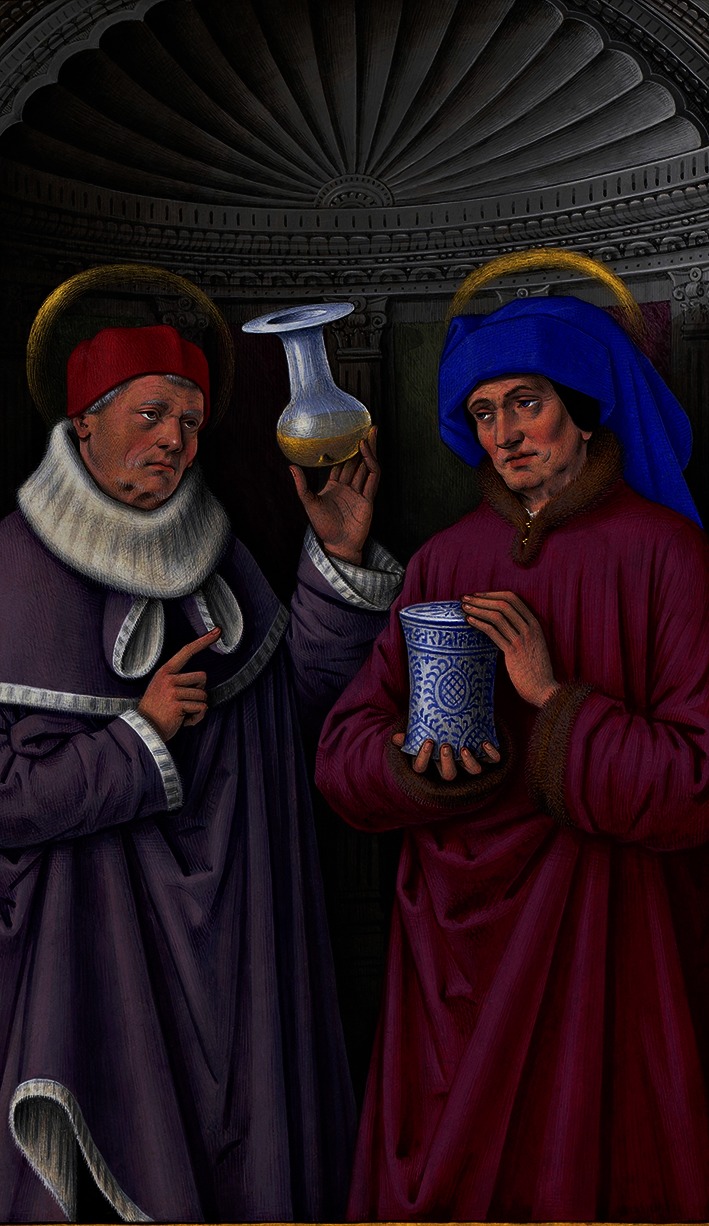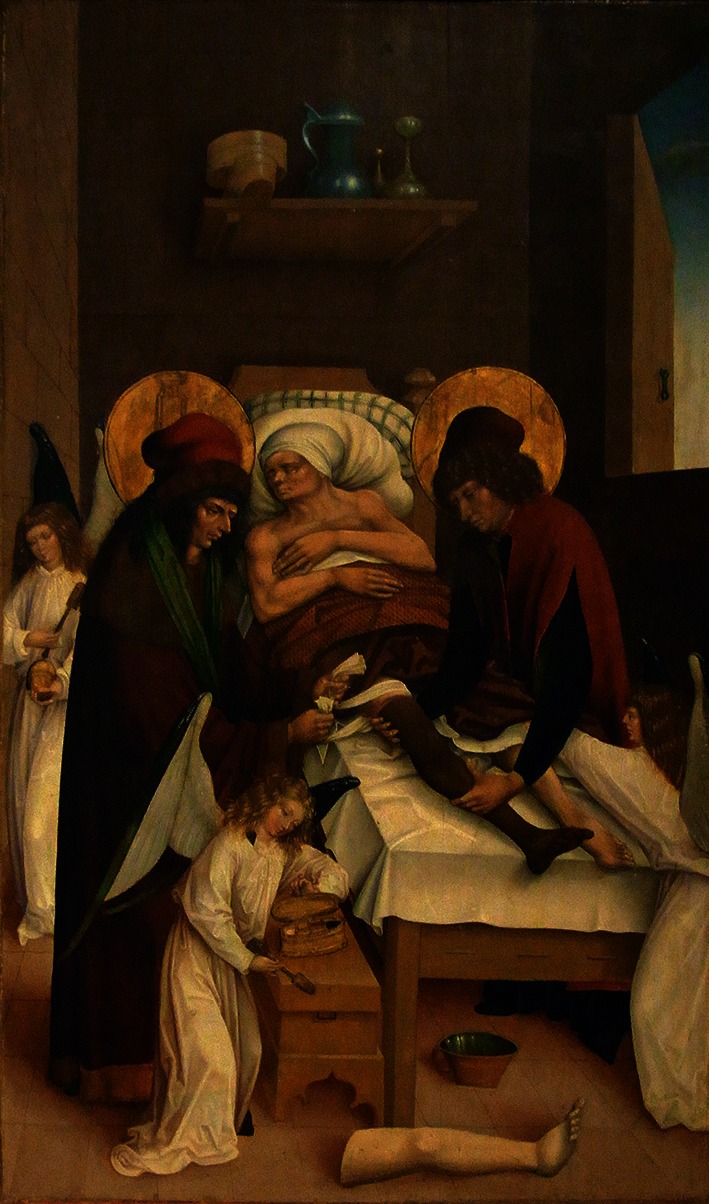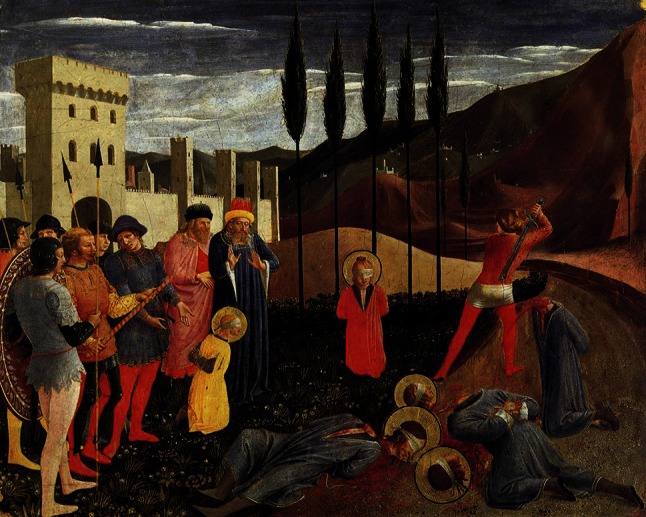The art of medicine in the 3rd to 4th centuries CE, similar to all times that preceded it, was largely based upon the potential healing benefits found by trial and error in the animal, plant, and mineral kingdoms. Surgical approaches to disease, as gleaned from surviving instruments, art, and printed materials, were characterized by cutting, scraping, and probing [4]. Most medical lore of the era was grounded in religious belief. Indeed, both the leading causes of illness and the most heralded successful treatments were ascribed to the acts of gods/God.
At the literal and figurative crossroads of Western civilization during these early centuries, as epitomized by commerce, education, and religion, lay Antioch [2]. Founded in 293 BC in ancient northern Syria, now southern Turkey, and near the Mediterranean coast, the region was host to multiple cultures and religions. The route between Antioch and Rome witnessed triumphs (birth of Christianity) and tragedies (First Crusade) of historical proportions and was the context that produced at least four patron saints of medicine. We will focus here on two of these physician-saints, Cosmas and Damian, and refer you to an elegant summary by Leonard Peltier of the lives of all four of these remarkable individuals, including Saint Luke the Apostle and Saint Panteleimon, which was published in Clinical Orthopaedics and Related Research ® in 1997 [5].
Cosmas and Damian were Arabian twins, born of devoutly Christian parents around 270 CE. They grew up with three other brothers in Aegeae, a small town between Turkey and Syria and on the route from Antioch to Tarsus, an ancient city in south-central Turkey near the Mediterranean Sea. This region was within the expansive Roman Empire, and the twins lived during the reign of Emperor Diocletian and his local governor, Lysias. In this time and place, the Roman state aggressively persecuted its Christians [1, 3, 5].
Raised by their mother, Theodota, and following the early death of their father, Cosmas and Damian studied medicine in Antioch and then returned to Aegeae to practice and proselytize. Portraits of the two brothers alone or with the rest of their family invariably show Cosmas and Damian holding boxes, tubes, or vessels associated with the medications or illnesses of the day (Fig 1). These devices serve as symbols of the medical and pharmaceutical professions, of which the twins were later embraced as patron saints. Indeed, they were similarly and consistently depicted in the visual arts with halos, a reflection of their piety and eventual sainthood.
Fig. 1.

Saints Cosmas (left) and Damian (right) are shown in a miniature from the Grandes Heures of Anne of Brittany (16th century). Painted by Jean Bourdichon.
As physicians, they reputedly never accepted payment for their services, and were referred to as anargyroi (Greek for “without silver” [1, 5]). In addition to the treatment of wounds, fractures and dislocations, Cosmas and Damian faced the challenges of widespread infectious diseases, including tuberculosis, malaria, typhus, and diphtheria. Blood-letting for sundry ailments was amongst their traditional therapies. So too were prayer and spiritual guidance, and they were advocates of an approach termed “incubation,” in which the sick would move into churches or sanctuaries to be closer to God—and, hopefully, to a cure [3].
Feats of uncommon medical prowess ascribed Cosmas and Damian included cures from dreaded infectious diseases, return of eyesight to the blind, as well as restoring ambulation to patients with disabilities. The most famous account of Cosmas and Damian’s divine exploits is “the miracle of the black leg.” Indeed, this story has captured the attention of many artists and authors for centuries [1, 5, 6]. While variations in some details are inevitable, the key elements of the miracle are consistent as they are depicted in art and described in writing. In some descriptions, the miracle is a posthumous event, happening hundreds of years after the martyrdom of Cosmas and Damian. The devout Deacon Justinian, who worked in the Saints’ Basilica on the outskirts of Rome, fell gravely ill with a gangrenous or cancerous leg and sought “incubation” and relief in the church. During a dream at the height of his delirium, Cosmas and Damian appeared and set out to amputate the diseased limb and end his anguish. At this moment, the physicians decided to acquire a replacement leg from a Moor or Ethiopian recently buried in a nearby cemetery, and thereby restore full function to their Christian patient. The Deacon awoke to find his body intact, free of his diseased limb, but in possession of a “transplant” characterized by the dark skin of his donor.
A frequently referenced painting of this miraculous procedure is attributed to an unknown artist (circa 1500) (Fig 2). As is usual, the scene focuses our attention on the dark limb attached to the patient. It is not until one thoroughly surveys the painting that the white limb is found in the foreground, leaving ambiguous to those unfamiliar with the legend whether the black leg is diseased and prior to “treatment,” or perhaps worse, a failure in the making!
Fig. 2.

The most famous account of Cosmas and Damian’s divine exploits is “the miracle of the black leg.” The miraculous procedure is attributed to an unknown artist (circa 1500).
True to lore, the patient is in quiet and comfortable repose, and except for the necessary access to his diseased limb, his modesty is preserved by well-positioned folded arms and bedding. Not a drop of blood unsettles or distracts the viewer from the dominant lesson of this scene: A miraculous intervention rewards a devout believer in need. It is perhaps ambiguous whether the brother on the left is tying or releasing a tourniquet, just as first glance leaves the viewer uncertain as to whether the procedure is starting or finishing. Unambiguous is the saintliness of the surgeons, depicted calm, skilled, and haloed, or the angelic attendants, one carefully arranging and readying earthly instruments, and another intent on the miraculous procedure and in awe of those she serves. There is a third angel at the viewer’s left, either observing or inspiring the saints. Despite perspective, it is clear this angel is larger than the other two, indicating a hierarchical “rank.” There is no mistaking the humble, albeit well-equipped, surrounding as would be expected in a holy sanctuary.
The technical nature of this painting is in keeping with 16th-century perceptions of the natural world, including the use of ambient light to highlight objects, the establishment of deep space, and the symmetry of presentation. The artist has taken advantage of an understanding of perspective. He has depicted space through the use of diagonals in the bed frame, the bench, the folds of the bed sheets, the transplanted limb, the window frame, and the floor tiles—all of which lead our eyes from the front to the back of the painting. Even the shelf above the bed is tilted to display its objects. Light emerging through the open window spotlights these canisters and bowls and breaks open the dull brown walls. The many lines and the folds in richly saturated colors of the fabric also add to a sense of activity and movement.
The scene of salvation is skillfully composed and framed by the symmetrical placement of people and objects. The orderly vases and bowls above the parishioner, angels, and saints on either side of the bed with their halos framing the patient, the diseased limb at the bottom foreground all help focus our attention and forbid our eyes from wandering outside the picture plane.
Many artists through a millennia (including many unknown Byzantine artists, Fra Angelico [1395–1455], Fernando del Rincon [1544–1517], and Ambrosius Francken the Elder [1544–1618] to name a few) depicted this same event. What all these paintings share is the faithful recounting of the most famous exploit of Saints Cosmas and Damian, the inseparable roles of faith and healing, and the rewards of a pious life.
The patron saints of medicine, however, were mercilessly punished for their devotion, both to the practice of healing and especially their religious commitments. On the orders of Diocletian, Cosmas and Damian were arrested for refusing to renounce their faith and then tortured by Lysias. They survived being crucified, stoned, and pierced by arrows, and were thrown bound into the ocean, only to be saved by angels. Cosmas and Damian, along with their three brothers, then were executed by beheading (Fig 3).
Fig. 3.

The patron saints of medicine were mercilessly punished for their devotion. Painter Fra Angelico depicts the martyrdom of Saints Cosmas and Damian and their three brothers (circa 1438–1440).
Their martyrdom was rewarded by sainthood and the dedication in their names of numerous churches and basilicas throughout the Middle East, Europe, and eventually North America. Their relics have been widely distributed and revered and a feast day established in their memory [3]. Today, we rejoice in the legends, lore, and beatification of Cosmas and Damian, Patron Saints of Medicine and Pharmacy. Their deeds and selfless motivation serve as reminders of our commitment to the best interests of our patients, and to a sense of charity, as we share our talents and comfort with all those in need.
Footnotes
Note from the Editor-in-Chief:
I am pleased to introduce the next installment of “Art in Science,” team-written by Gary Friedlaender and Linda Friedlaender. Gary is the Wayne O. Southwick Professor, and Chair Emeritus for the Department of Orthopaedics and Rehabilitation at Yale School of Medicine; Linda Friedlaender is the Senior Curator of Education at the Yale Center for British Art. Together, they will share observations from a fascinating vantage point: The intersection of art and medicine.
The authors certify that they or any member of their immediate families have no funding or commercial associations (eg, legal, consultancies, stock ownership, equity interest, patent/licensing arrangements, etc) that might pose a conflict of interest in connection with the submitted article.
All ICMJE Conflict of Interest Forms for authors and Clinical Orthopaedics and Related Research ® editors and board members are on file with the publication and can be viewed on request.
The opinions expressed are those of the writers, and do not reflect the opinion or policy of CORR ® or The Association of Bone and Joint Surgeons®.
References
- 1.Androutsos G, Diamantis A, Vladimiros L. The first leg transplant for the treatment of a cancer by Saints Cosmas and Damian. J BUON. 2008;13:297–304. [PubMed] [Google Scholar]
- 2.Bouchier ES. A Short History of Antioch, 300 B.C.-A.D. 1268. Charleston, SC: Bibliolife; 2009.
- 3.Duffin J. Medical Saints. Cosmas and Damian in a Postmodern World. New York, NY: Oxford University Press; 2013.
- 4.Haeger K. The Illustrated History of Surgery. New York, NY: Bell Publishing Company; 1988. p. 50. [Google Scholar]
- 5.Peltier LF. Patron saints of medicine. Clin Orthop Rel Res. 1997;334:374–379. [PubMed] [Google Scholar]
- 6.Rinaldi E. The first homoplastic limb transplant according to the legend of Saint Cosmas and Saint Damian. Ital J Orthop Trauma. 1987;13:393–406. [PubMed] [Google Scholar]


